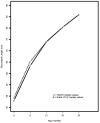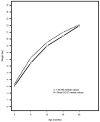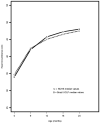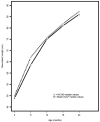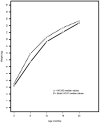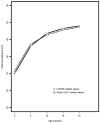Longitudinal study of growth of children with unilateral cleft-lip palate from birth to two years of age
- PMID: 19860503
- PMCID: PMC2787972
- DOI: 10.1597/08-105.1
Longitudinal study of growth of children with unilateral cleft-lip palate from birth to two years of age
Abstract
Objective: To study the growth of children with complete unilateral cleft lip and palate (UCLP) from birth to 2 years of age and to construct specific UCLP growth curves.
Design: Physical growth was a secondary outcome measure of a National Institutes of Health-sponsored longitudinal, prospective clinical trial involving the University of Florida (United States) and the University of São Paulo (Brazil).
Patients: Six hundred twenty-seven children with UCLP, nonsyndromic, both genders.
Methods: Length, weight, and head circumference were prospectively measured for a group of children enrolled in a clinical trial. Median growth curves for the three parameters (length, weight, head circumference) were performed and compared with the median for the National Center for Health Statistics (NCHS) curves. The median values for length, weight, and head circumference at birth and 6, 12, 18, and 24 months of age were plotted against NCHS median values and statistically compared at birth and 24 months.
Setting: Hospital de Reabilitação de Anomalias Craniofaciais, Universidade de São Paulo, Bauru, Brazil (HRAC-USP).
Results: At birth, children of both genders with UCLP presented with smaller body dimensions in relation to NCHS median values, but the results suggest a catch-up growth for length, weight, and head circumference for girls and for weight (to some degree) and head circumference for boys.
Conclusions: Weight was the most compromised parameter for both genders, followed by length and then head circumference. There was no evidence of short stature. This study established growth curves for children with UCLP.
Figures
References
-
- Becker M, Svensson H, Kallen B. Birth weight, body length, and cranial circumference in newborns with cleft lip or palate. Cleft Palate Craniofac J. 1998;35:255–261. - PubMed
-
- Bowers EJ, Mayro RF, Whitaker LA, Pasquariello OS, LaRossa D, Randall P. General body growth in children with clefts of the lip, palate and craniofacial structure. Scand J Plast Reconst Surg. 1987;21:7–14. - PubMed
-
- Coy K, Speltz ML, Jones K, Hill S, Omnell ML. Do psychosocial variables predict the physical growth of infants with orofacial clefts? J Dev Behav Pediatr. 2000;21:198–206. - PubMed
-
- Cunningham ML, Jerome JT. Linear growth characteristics of children with cleft lip and palate. J Pediatr. 1997;131:707–711. - PubMed
-
- Day WD. Accurate diagnosis and assessment of growth in patients with orofacial clefting. Birth Defects. 1985;21:1–14. - PubMed

